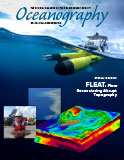Article Abstract
The ocean’s response to the termination of the major 2015/2016 El Niño event was captured from moorings and gliders deployed near Palau as part of the Office of Naval Research Departmental Research Initiative Flow Encountering Abrupt Topography (FLEAT). As the El Niño transitioned to neutral conditions in spring 2016, pulses of positive (warm) sea surface height anomalies (SSHAs) moved westward, deepening the thermocline and reaching Palau by the end of March. Observations collected nearly two months after the arrival of the warm water revealed intraseasonal oscillations (ISOs) with periods of ~30 days and vertical displacements of isotherms exceeding ~100 m in the deeper part of the thermocline. Arrival of these warm anomalies coincided with the disappearance of the eastward flow associated with the North Equatorial Countercurrent, and anomalously large meridional velocities (0.4 m s–1) and transports (~4–6 Sv) over the Kyushu-Palau Ridge on the northern edge of Palau. The 120-day, high-pass-filtered, satellite-acquired SSHAs showed packets of westward-moving waves with phase speeds of about 0.2 m s–1 at 8.625°N, with horizontal wavelengths and periods of about 550 km and 30 days, respectively. These waves, which appear to originate in the western Pacific, fall within the characteristics of mode-1 and mode-2 Rossby waves. Similar SSHAs were found near Palau following previous El Niño events, suggesting that formation of intraseasonal oscillations is part of an oceanic response to the termination of El Niño. The transition from El Niño to neutral conditions can affect the coral ecosystem around Palau by creating anomalous circulation and strong thermal anomalies extending from the surface to bottom waters deeper than 150 m, far below the depth limit of coral growth in Palau.

